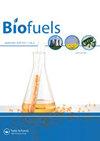Evaluating the properties of a novel diesel-like fuel produced by biochar-assisted catalytic cracking of waste motor oil
IF 2.6
4区 工程技术
Q3 ENERGY & FUELS
引用次数: 0
Abstract
AbstractIn light of the need for sustainable and eco-friendly alternatives to conventional fuels, waste-based diesel-like fuels have emerged as a promising solution. This study explores the chemical, physical, and rheological properties of a diesel-like fuel (DLF) produced via chemical recycling of waste motor oil (WMO) using an alkali-treated rice husk biochar as a catalyst. DLF from biochar-assisted cracking (DLFB) resembles commercial diesel hydrocarbon distribution better than DLF from thermal cracking, which shows to many molecules in the gasoline range. DLFB meets the minimum requirements for commercial diesel as per ASTM standards. The study also presents the rheological properties of the DLFB and its blends with commercial diesel, assessing their flow behavior under various operating conditions. The results indicate that all samples exhibit Newtonian behavior. The shear stress rises with the shear rate in a linear manner. Moreover, rheograms indicate that viscosity gradually decreasing with temperature. The obtained DLFB resembles commercial diesel in chemical composition when analyzed via through FTIR and GC-MS analysis, though with a small presence of low-molecular-weight hydrocarbons. In summary, these results demonstrate the potential of this novel DLFB as a sustainable fuel, given its favorable properties and the circular approach applied to the valorization of WMO. HighlightsBiomass-based catalytic recycling of waste motor oil to obtain diesel-like fuels (DLFs).DLFB meet commercial diesel standards and exhibit favorable rheological properties.DLFB potential as sustainable fuel with a similar composition to commercial diesel.Keywords: Diesel-like fuelchemical recyclingwaste motor oilbiocharsustainable fuel Author contributionEvelyn Juiña: Investigation, Writing - original draft, Formal analysis.Sebastian Taco-Vasquez: Investigation, Formal analysis.Karla Vizuete: Visualization, Writing - review & editing, Validation.Alexis Debut: Visualization, Writing - review & editing, Validation.Herman A. Murillo: Data curation, Conceptualization, Formal analysis, Writing - original draft.Sebastian Ponce: Data curation, Conceptualization, Formal analysis, Writing - original draft.Disclosure statementNo potential conflict of interest was reported by the author(s).Data availability statementData sharing is not applicable to this article as no datasets were generated or analyzed during the current study.Additional informationFundingThis research has been supported by the Poligrant 2022–2023 and Collaboration Grant 2022–2023 programs provided by Universidad San Francisco de Quito.生物炭辅助催化裂解废机油制备新型类柴油燃料的性能评价
鉴于需要可持续和环保的传统燃料替代品,基于废物的类柴油燃料已经成为一种很有前途的解决方案。本研究探讨了用碱处理过的稻壳生物炭作为催化剂,通过废旧机油(WMO)的化学回收生产的类柴油燃料(DLF)的化学、物理和流变特性。从生物炭辅助裂解(DLFB)得到的DLF比从热裂解得到的DLF更接近于商业柴油的碳氢化合物分布,这表明在汽油范围内有许多分子。DLFB符合ASTM标准对商用柴油的最低要求。该研究还介绍了DLFB及其与商用柴油共混物的流变特性,评估了它们在各种工况下的流动特性。结果表明,所有样品都表现出牛顿行为。剪切应力随剪切速率线性上升。流变图显示粘度随温度的升高而逐渐降低。通过FTIR和GC-MS分析,所得DLFB在化学成分上与商用柴油相似,但含有少量低分子量碳氢化合物。综上所述,这些结果证明了这种新型DLFB作为可持续燃料的潜力,因为它具有良好的性能和用于WMO增值的循环方法。生物质基催化回收废机油以获得类柴油燃料(DLFs)。DLFB符合商用柴油标准,具有良好的流变性能。DLFB作为可持续燃料的潜力,其成分与商用柴油相似。关键词:类柴油燃料化学回收废马达油生物炭可持续燃料作者投稿evelyn Juiña:调查,写作-原稿,形式分析Sebastian Taco-Vasquez:调查,形式分析。Karla Vizuete:可视化,写作-审查和编辑,验证。亚历克西斯首次亮相:可视化,写作-审查和编辑,验证。赫尔曼A.穆里略:数据管理,概念化,形式分析,写作-原稿。塞巴斯蒂安庞塞:数据管理,概念化,形式分析,写作-原稿。披露声明作者未报告潜在的利益冲突。数据可用性声明数据共享不适用于本文,因为在当前研究期间没有生成或分析数据集。本研究得到了由基多旧金山大学提供的2022-2023年Poligrant项目和2022-2023年合作基金项目的支持。
本文章由计算机程序翻译,如有差异,请以英文原文为准。
求助全文
约1分钟内获得全文
求助全文
来源期刊

Biofuels-Uk
Energy-Renewable Energy, Sustainability and the Environment
CiteScore
5.40
自引率
9.50%
发文量
56
期刊介绍:
Current energy systems need a vast transformation to meet the key demands of the 21st century: reduced environmental impact, economic viability and efficiency. An essential part of this energy revolution is bioenergy.
The movement towards widespread implementation of first generation biofuels is still in its infancy, requiring continued evaluation and improvement to be fully realised. Problems with current bioenergy strategies, for example competition over land use for food crops, do not yet have satisfactory solutions. The second generation of biofuels, based around cellulosic ethanol, are now in development and are opening up new possibilities for future energy generation. Recent advances in genetics have pioneered research into designer fuels and sources such as algae have been revealed as untapped bioenergy resources.
As global energy requirements change and grow, it is crucial that all aspects of the bioenergy production process are streamlined and improved, from the design of more efficient biorefineries to research into biohydrogen as an energy carrier. Current energy infrastructures need to be adapted and changed to fulfil the promises of biomass for power generation.
Biofuels provides a forum for all stakeholders in the bioenergy sector, featuring review articles, original research, commentaries, news, research and development spotlights, interviews with key opinion leaders and much more, with a view to establishing an international community of bioenergy communication.
As biofuel research continues at an unprecedented rate, the development of new feedstocks and improvements in bioenergy production processes provide the key to the transformation of biomass into a global energy resource. With the twin threats of climate change and depleted fossil fuel reserves looming, it is vitally important that research communities are mobilized to fully realize the potential of bioenergy.
 求助内容:
求助内容: 应助结果提醒方式:
应助结果提醒方式:


